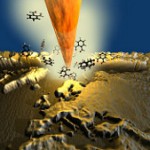Congratulations to Professors Pierre-Emmanuel Gaillardon and Kay Park who recently received a University of Utah Research Instrumentation Fund for “Shared High-Resolution Nanolithography System”. This fund will help bring the SwissLitho AG NanoFrazor to the University of Utah Nanofab cleanroom facility.
The SwissLitho NanoFrazor will provide:
- High‐resolution direct write nanolithography: Resist is directly vaporized during the NanoFrazor patterning process and hence no development and no proximity correction is necessary. This enables patterning of complex shapes that are not possible to achieve with e‐beam The written shape reflects the tip geometry. Resolution below 50 nm half‐pitch is achieved on a regular basis, below 10 nm has been demonstrated.

- 3D nanolithography: 3D topographical structures can be written in just one step and with unmatched accuracy. Patterning of resists like PPA allows better than 2nm vertical
- In‐situ topography imaging: The NanoFrazor Scholar uses the same tip for patterning as well as for imaging the topography of the substrate with sub-‐nm vertical resolution and single nanometer lateral resolution.
- Closed-‐loop lithography: The final shape of the written pattern is continuously measured. Deviations from the target are used as input for immediate automated adjustments of the patterning parameters, like e.g. the applied contact force of the tip to the
- Stitching and overlay: The in‐situ topographic imaging capability also enables possibilities for stitching and overlay. The natural surface roughness of the resist provides perfect properties for field stitching using correlation techniques without any marker structures. Furthermore, the remaining topography of nanostructures (e.g. nanowires) buried under the spin‐coated resist is also detectable, allowing extremely accurate overlay alignment to these structures (e.g. nanowires) is achieved.
- No damage from charged particle beam: Beam‐based nanolithography technologies, such as electron or ion beam, can charge substrate materials and often permanently damage the The resist in e‐beam lithography absorbs only a small fraction of the beam energy and the majority of the beam energy is actually absorbed by the substrate. This is in contrast to the NanoFrazor, where the energy in form of heat is largely absorbed in the top layer of the resist stack. Heating of the underlying substrate is negligible and delicate materials stay unharmed.
- Thermal nanoscale experiments: The temperature of the tip’s microheater can be controlled accurately between room temperature and up to around 1000°C. This allows precise triggering of chemical reactions or phase transitions at the nanoscale besides the usual topographical nanopatterning by evaporating resists. In addition, a wide range of contact forces and reaction times can be applied to study such reactions or to find the optimum chemical patterning conditions for any new materials being tested.
The NanoFrazor technology is currently available in the following institutions: ETHZ (Switzerland), EPFL (Switzerland), IBM Research (Switzerland), Beihang University (China), Melbourne University (Australia), McGill (Canada) and Air Force Research Laboratory (USA). As a result, we will be the first university in the US to acquire this technology providing us a competitive advantage to obtain research results exploiting the capabilities of the tool and helping us secure new grants.